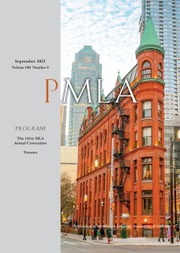No CrossRef data available.
Article contents
Mariama Bâ, Younousse Seye, and the Ambivalence of Canonization
Published online by Cambridge University Press: 06 January 2025
Abstract
An abstract is not available for this content so a preview has been provided. Please use the Get access link above for information on how to access this content.

- Type
- Theories and Methodologies
- Information
- Copyright
- Copyright © 2024 The Author(s). Published by Cambridge University Press on behalf of Modern Language Association of America
References
Works Cited
Adotevi, Stanislas. “Address by the Delegation of the Republic of Dahomey.” African Culture, pp. 84–89.Google Scholar
African Culture: Algiers Symposium, July 21st–August 1st 1969. Société Nationale d’Édition et de Diffusion, 1969.Google Scholar
Apter, Andrew. “Beyond Négritude: Black Cultural Citizenship and the Arab Question in FESTAC 77.” Journal of African Cultural Studies, vol. 28, no. 3, 2005, pp. 313–26.CrossRefGoogle Scholar
Asma'u, Nana. Collected Works of Nana Asma'u, Daughter of Usman dan Fodiyo (1793–1864). Translated and edited by Boyd, Jean and Mack, Beverly, Michigan State UP, 1997.Google Scholar
Bâ, Mariama. “Festac . . . Memories of Lagos.” Translated by Tobias Warner. PMLA, vol. 138, no. 5, Oct. 2023, p. 1175.Google Scholar
Barthélémy, Pascale. “‘Je suis une Africaine . . . j'ai vingt ans’: Écrits féminins et modernité en Afrique occidentale française (c. 1940–c. 1950).” Annales, vol. 64, no. 4, 2009, pp. 825–52.CrossRefGoogle Scholar
Bower, Rachel. “Poetry, Parenting, and Nigeria.” Rachel Bower, 18 Dec. 2018, rachelbower.net/2018/12/18/poetry-parenting-and-nigeria/.Google Scholar
Brière, J. F. “Younousse Sèye ou la recherche archaéologique.” L'Ouest Africain, 3–10 Nov. 1972, p. 8.Google Scholar
Bush, Ruth. “‘Mesdames, il faut lire!’ [‘Ladies, you must read!’]: Material Contexts and Representational Strategies in the First Francophone African Women's Magazine.” Francosphères, vol. 5, no. 2, 2009, pp. 213–36.CrossRefGoogle Scholar
Césaire, Aimé. Cahier d'un retour au pays natal / Notebook of a Return to the Native Land. Bilingual ed., translated and edited by James Arnold, A. and Eshleman, Clayton, Wesleyan UP, 2013.Google Scholar
Edwards, Brent Hayes. “Aimé Césaire and the Syntax of Influence.” Research in African Literatures, vol. 36, no. 2, 2005, pp. 1–18.Google Scholar
Edwards, Brent Hayes. “Unsettled Legacies.” PMLA, vol. 136, no. 5, Oct. 2021, pp. 681–95.Google Scholar
Enahoro, Anthony. Document VII/120. Eighth Meeting of the International Festival Committee at Lagos, International Festival Committee Papers, Center for Black and African Arts and Civilization, Lagos, box 7.Google Scholar
Faik-Nzuji, Clémentine, et al. “Au premier Festival Culturel Panafricain: Impressions du Symposium.” Congo-Afrique, Jan. 1970, pp. 383–99.Google Scholar
Fejzula, Merve. “Gendered Labour, Negritude and the Black Public Sphere.” Historical Research, vol. 95, no. 269, 2022, pp. 423–46.CrossRefGoogle Scholar
Hunt-Ehrlich, Madeleine. Panel discussion following screening of The Ballad of Suzanne Césaire. BlackStar Film Festival, 4 Aug. 2024.Google Scholar
Jaji, Tsitsi Ella. “Bingo: Francophone African Women and the Rise of the Glossy Magazine.” Popular Culture in Africa: The Episteme of the Everyday, edited by Newell, Stephanie and Okome, Onookome, Routledge, 2013, pp. 111–30.Google Scholar
Joseph-Gabriel, Annette K. Reimagining Liberation: How Black Women Transformed Citizenship in the French Empire. U of Illinois P, 2020.Google Scholar
Lindfors, Bernth. “Anti-Negritude in Algiers.” Africa Today, vol. 17, no. 1, 1970, pp. 5–7.Google Scholar
Malaquais, Dominique, and Vincent, Cédric. “PANAFEST: A Festival Complex Revisited.” The First World Festival of Negro Arts, Dakar 1966, edited by Murphy, David, Liverpool UP, 2016, pp. 204–12.Google Scholar
M'Bow, Amadou-Mahtar. “Address by the Delegation of the Republic of Senegal.” African Culture, pp. 148–52.Google Scholar
Meagher, Kate. “Reflections of an Engaged Economist: An Interview with Thandika Mkandawire.” Development and Change, vol. 50, no. 2, 2019, pp. 1–31.CrossRefGoogle Scholar
Ndiaye, Mame Coumba. Mariama Bâ; ou, Les allées d'un destin. Nouvelles Éditions Africaines, 2007.Google Scholar
Newell, Stephanie. Newsprint Literature and Local Literary Creativity in West Africa, 1900s–1960s. James Currey, 2023.Google Scholar
Newell, Stephanie. The Power to Name: A History of Anonymity in West Africa. Ohio UP, 2013.Google Scholar
Roscoe, Andrian A. Mother Is Gold: A Study of West African Literature. Cambridge UP, 1971.Google Scholar
Seye, Younousse. “Younousse Seye: Peintre.” Interview conducted by Annette Mbaye d'Erneville. Awa, Nov. 1972, p. 22.Google Scholar
Suhr-Sytsma, Nathan. Poetry, Print, and the Making of Postcolonial Literature. Cambridge UP, 2017.CrossRefGoogle Scholar
Warner, Tobias. “How Mariama Bâ Became World Literature: Translation and the Legibility of Feminist Critique.” PMLA, vol. 131, no. 5, Oct. 2016, pp. 1239–55.Google Scholar


